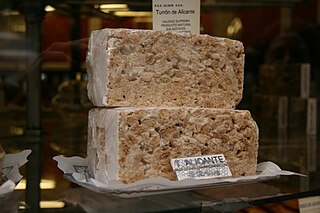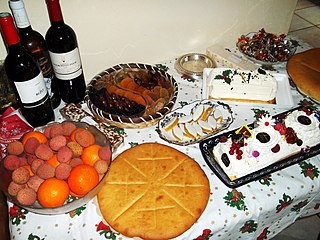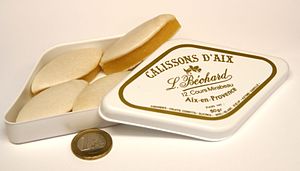
Confectionery is the art of making confections, which are food items that are rich in sugar and carbohydrates. Exact definitions are difficult. In general, however, confectionery is divided into two broad and somewhat overlapping categories: bakers' confections and sugar confections. The occupation of confectioner encompasses the categories of cooking performed by both the French patissier and the confiseur.

Provence is a geographical region and historical province of southeastern France, which extends from the left bank of the lower Rhône to the west to the Italian border to the east; it is bordered by the Mediterranean Sea to the south. It largely corresponds with the modern administrative region of Provence-Alpes-Côte d'Azur and includes the departments of Var, Bouches-du-Rhône, Alpes-de-Haute-Provence, as well as parts of Alpes-Maritimes and Vaucluse. The largest city of the region and its modern-day capital is Marseille.

Aix-en-Provence, or simply Aix, is a city and commune in southern France, about 30 km (20 mi) north of Marseille. A former capital of Provence, it is the subprefecture of the arrondissement of Aix-en-Provence, in the department of Bouches-du-Rhône, in the region of Provence-Alpes-Côte d'Azur. The population of Aix-en-Provence is approximately 145,000. Its inhabitants are called Aixois or, less commonly, Aquisextains.

Turrón and torrone is a southwest European nougat confection, typically made of honey, sugar, and egg white, with toasted almonds or other nuts, and usually shaped either into a rectangular tablet or a round cake. Turrón is usually eaten as a dessert food around Christmas in Spain and Italy. It's also known in Portugal and the countries of Latin America.

Marzipan is a confection consisting primarily of sugar, honey, and almond meal, sometimes augmented with almond oil or extract.

Île-d'Aix is a commune in the French department of Charente-Maritime, region of New Aquitaine, off the west coast of France. It occupies the territory of the small Isle of Aix, in the Atlantic Ocean. It is a popular place for tourist day-trips during the summer months.

Dutch cuisine is formed from the cooking traditions and practices of the Netherlands. The country's cuisine is shaped by its location in the fertile North Sea river delta of the European Plain, giving rise to fishing, farming and overseas trade. The Burgundian-Habsburg court enriched the cuisine of the Dutch elite in the 15th and 16th century, so did the colonial spice trade in the 17th century.

Almond paste is made from ground almonds or almond meal and sugar in equal quantities, with small amounts of cooking oil, beaten eggs, heavy cream or corn syrup added as a binder. It is similar to marzipan, but has a coarser texture. Almond paste is used as a filling in pastries, but it can also be found in chocolates. In commercially manufactured almond paste, ground apricot or peach kernels are sometimes added to keep the cost down.

A Konditorei is a business that typically offers a wide variety of pastries and typically also serves as a café. Konditoreien (plural) are found in many different countries including but not limited to Germany, Austria, Switzerland, France, Denmark, Sweden, and the Czech Republic. In French-speaking countries, similar businesses are referred to as pâtisseries.

Aix Cathedral in Aix-en-Provence in southern France is a Roman Catholic church and the seat of the Archbishop of Aix-en-Provence and Arles. The cathedral is built on the site of the 1st-century Roman forum of Aix. Built and re-built from the 12th until the 19th century, it includes Romanesque, Gothic and Neo-Gothic elements, as well as Roman columns and parts of the baptistery from a 6th-century Christian church. It is a national monument of France.

Le Tholonet is a commune in the Bouches-du-Rhône department in southern France. Its inhabitants are called Tholonétiens.

Pays d'Aix Football Club, also known as Aix FC is a French association football club based in the city of Aix-en-Provence. The team was founded in 1941 as a merger of Football Club Aixois and Union Sportive Aixoise football clubs. Their best result was playing in French Division 1 in the 1967–68 season, where they finished bottom. Four years later they were further relegated to third level. They spent the following four decades playing in lower level amateur levels. In 2014, the club was renamed from AS Aix to Pays d'Aix FC to mark a rupture with the club's complicated past. As of the 2019–20 season, Pays d'Aix currently play in Provence Départemental 3 in the tenth tier of the French league system.

The thirteen desserts are the traditional dessert foods used to celebrate Christmas in the French region of Provence. The "big supper" ends with a ritual 13 desserts, representing Jesus Christ and the 12 apostles. The desserts always number thirteen but the exact items vary by local or familial tradition. The food traditionally is set out Christmas Eve and remains on the table three days until December 27.

The Church of St. John in Aix-en-Provence, situated at the corner of rue d'Italie and rue Cardinale, is a Gothic Roman Catholic church, the first in Provence. It was built in the 13th century, mostly in the 1270s.
Nougat de Montélimar is a confection speciality produced in Montélimar in the department of Drôme in France.
Impade is a cookie of Sephardi Jewish origin that is most commonly found among members of the Venetian Jewish community and their descendants, and is traditionally prepared at Purim, but is also prepared year round.















